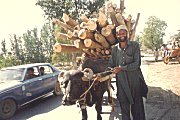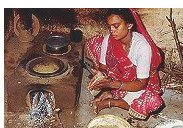

India 
 |
Wood Energy Situation Policies and Programmes Wood Energy Data Further Reading RWEDP Focal Points |
Wood Energy Situation
In 1994, wood energy consumption in India was 3,290 PJ, or 30% of total energy consumption. Most woodfuels are used in the domestic sector in both urban and rural areas. Fuelwood is the dominant fuel source, but dung and agricultural residues are also widely used. Dung is only used in the domestic sector, but crop residues are used in the industrial sector too. One would have expected that the dependence on biomass energy would have declined with the country's economic development. However, studies over 20 years show that the use of biomass energy sources such as fuelwood, crop residues and dung have increased considerably. Rural population growth and the absence of alternative fuels are the main reasons for this.
India differs from most other RWEDP-member countries in that the main causes of deforestation have not been the extension of agricultural land or forest encroachment. In fact, the required increase in agricultural output for the growing population is being met by increased productivity. Deforestation actually stopped in 1988 and now there is even a slight increase in forest cover, which also has improved the fuelwood situation.
It is rather difficult to get an overview of woodfuel scarcity in India. Some areas have severe fuel problems, although it seems the situation has not worsened over the last few years.
Policies and Programmes
 India's ongoing Integrated Rural Energy Planning (IREP) includes wood energy and has been a long-term programme under the guidance of the Planning Commission. In 1995, IREP was incorporated into the Ministry of New Energy Sources (MNES), which may lead to improved co-ordination. MNES has been conducting several national (rural) energy supply and conservation programmes and has linked them to its State Nodal Points. Further MNES is interested in dendro-thermal power generation, and plans are being made to pool expertise with RWEDP and other countries. Links between MNES, the Forestry Department and the Rural Development Department are being strengthened.
India's ongoing Integrated Rural Energy Planning (IREP) includes wood energy and has been a long-term programme under the guidance of the Planning Commission. In 1995, IREP was incorporated into the Ministry of New Energy Sources (MNES), which may lead to improved co-ordination. MNES has been conducting several national (rural) energy supply and conservation programmes and has linked them to its State Nodal Points. Further MNES is interested in dendro-thermal power generation, and plans are being made to pool expertise with RWEDP and other countries. Links between MNES, the Forestry Department and the Rural Development Department are being strengthened.
In addition to the named MNES and Ministry of Environment and Forest, the Ministry for Wasteland Development is potentially a major actor on the wood energy scene. India is known for devoting much expertise in specialised fields, and the country is engaged in many development efforts. However, these are sometimes hindered by India's size, and limited co-ordination.
Wood Energy Data
| General | |||||
| Population (1996) | 944.6 mln. | ||||
| Share of Rural Population | 72.9% | ||||
| GDP per capita (1995) in constant 1987 US$ | 405 | ||||
| Energy Consumption (1996) | |||||
| Total Final Energy Consumption in PJ | 13,224 | ||||
| Consumption of Wood Energy in PJ | 3,831 | (29.0%) | |||
| Consumption of Biomass Energy in PJ | 6,316 | (47.8%) | |||
| Wood Energy Resources | |||||
| Forest Area (1995) in 1000 ha | 65,005 | (21.9%) | |||
| Natural Forest Area (1995) in 1000 ha | 50,385 | (16.9%) | |||
| Agricultural Area (1994) in 1000 ha | 181,000 | (60.9%) | |||
| Share of Woodfuels from Forest Areas (1996) | 51% | ||||
| Potential Wood Energy Supply (1994) | |||||
| Sust. Supply from Natural Forest in kton | 35,800 | ||||
| Sust. Supply from Forest Plantations in kton | 49,895 | ||||
| Sust. Supply from Agriculture Areas in kton | 125,323 | ||||
| Sust. Supply from Other Wooded Land in kton | 5,150 | ||||
| Supply from Wood Waste from Deforestation in kton | 18,999 | ||||
| Total Potential Supply in kton | 235,167 | ||||
| Primary Wood Energy Requirements in kton | 173,412 | ||||
Notes:
Population and land use data from FAO (FAOSTAT), GDP per capita from World Bank. Energy consumption data from various sources.
Potential wood energy supply estimated by RWEDP, based on available data for land use, wood productivity and estimates on availability of wood for energy use. For forest land, other wooded land and agriculture areas, the potential supply is based on average annual yield estimates, assuming a sustainable use of resources (Sust.: sustainable). Wood waste from deforestation refers to wood potentially available from natural forest land cleared due to commercial logging, expansion of agriculture land or other reasons. The estimates are based on aggregated national data, which can hide local variations, ranging from scarcity to abundance. For detailed calculations and estimates for 2010, see FD50, chapter 8
Further reading:
| Regional Study on Wood Energy Today and Tomorrow in Asia, Field Document 50, 1997 | |
| The Woodfuel Scenario and Policy Issues in India, Field Document 49, 1997 | |
| Chapter 6 in Review of Wood Energy Data in RWEDP Member Countries, Field Document 47, 1997 | |
| Report Woodfuel Flows: An overview of four studies, RWEDP Report No. 30, 1997 | |
| Indian Improved Cookstoves: A Compendium, Field Document 41, 1993 | |
| Charcoal Production and Marketing in Gujarat, Field Document 36, 1993 | |
| Small Scale Multipurpose Tree Production Systems in a Mountainous Region of India, Field Documents No. 28, 1991 | |
| Oak - Production, Management and Use in the Himalayas, Field Documents No. 27, 1991 | |
| Tree and Fuelwood from Non-Forest Lands, A Methodology for Assessment - India, Field Documents No. 23, 1990 | |
| Wood Based Energy System in Rural Industries and Village Applications - India, Field Documents No. 18, 1989 | |
| Development of Degraded Village Lands in India, Experiences and Prospects, Field Documents No. 15, 1989 | |
| Problems and Potentials of Reforestation of Salt Affected Soils in India, Field Documents No. 14, 1989 |
Focal points are the main contacts for RWEDP in a member country. Generally, in each country, there is one focal point in the energy sector, and one in the forestry sector.
| Inspector General of Forests Ministry of Environment and Forests Paryavaran Bhaban Block B CGO Complex Lodhi Road, New Delhi TEL: 91-11-361509 FAX: 91-11-4363957 | Secretary Ministry of Non-Conventional Energy Sources Block No. 14, CGO Complex Lodhi Road, New Delhi 110003 TEL: 91-11-4362772 FAX: 91-11-4361298/4361152 |
Comments, questions? webmaster@rwedp.org
© FAO-RWEDP, 1999